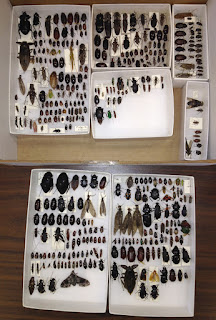I've been particularly intrigued by the Coastal Plain, owing mainly to its recent recognition as an important 'Biodiversity Hotspot' (a designation reflecting a biota that is both unique and threatened). The lowcountry holds quite a surprising range of unusual habitats, which we can only assume (for the most part) will be reflected by a surprising number of unusual beetle species. This has in fact been increasingly demonstrated by a small number of researchers, and I've become more and more pulled out of the mountains, my more typical haunt.
This summer we're emphasizing the sandhills, and have made a couple of productive trips to interesting sandhill habitat. This region runs along the Fall Line, the innermost edge of ancient (Pliocene) shoreline incursion. These sandhills basically represent ancient beaches, and the sandy soils, now far from the coast, host a particularly large proportion of lowland endemic species. This is obvious in the floras, and in the vertebrate faunas, exemplified by the eastern gopher tortoise especially. Insect-wise, the area is producing a diversity of unique bees and grasshoppers, hosts the relict scarabaeoid Mycotrupes, and no doubt holds surprises in other groups.
In June Mike Ferro, Laura Vasquez-Velez and I made a trip to the Aiken Gopher Tortoise Preserve. This area hosts an active (though reintroduced) gopher tortoise population, of which we saw abundant evidence. We sifted litter, beat plants, netted some beautiful ponds, and ran lights. The material is mostly still in preparation, but it was a fantastic haul for a day and an evening. Here's a few pictures, before I go on to our more recent sandhill adventure.
Then, just this past week, Mike and I made a foray to another beautiful site, the Carolina Sandhills National Wildlife Refuge. The drill was pretty much the same: Arrive mid-afternoon, collect under the blazing sun, sweat profusely, eat dinner, rehydrate, run blacklights until midnight, then make the 3+ hour drive back to Clemson. Yes, these places are only marginally habitable during summer. Oh, and get some chigger bites (though nothing to rival last summer's infestation). Still, persistence pays off, and we had a great catch. Two of the highlights (neither photographed yet) were a pretty rare myrmecophilous aleocharine rove beetle, Ecitoxenidia (Taro Eldredge's picture here), and a histerid beetle new to South Carolina, only recently described by me and Alexey Tishechkin from Oklahoma, Louisiana, and Florida, Baconia stephani (our published picture here). So the pattern known for well known groups seems to hold - there's some interesting beetles in the sandhills! Here's a random sampling of pictures from Carolina Sandhills NWR.








































